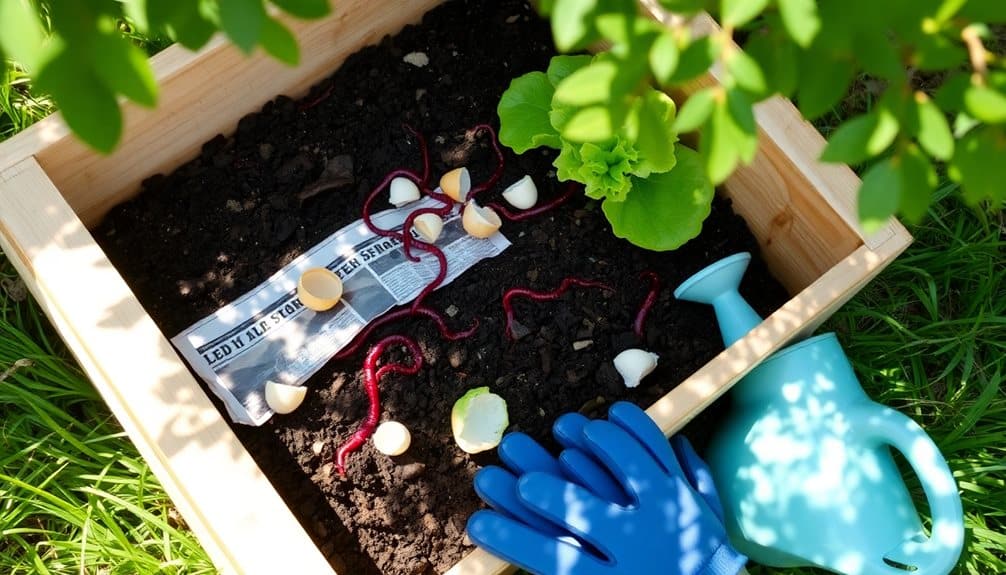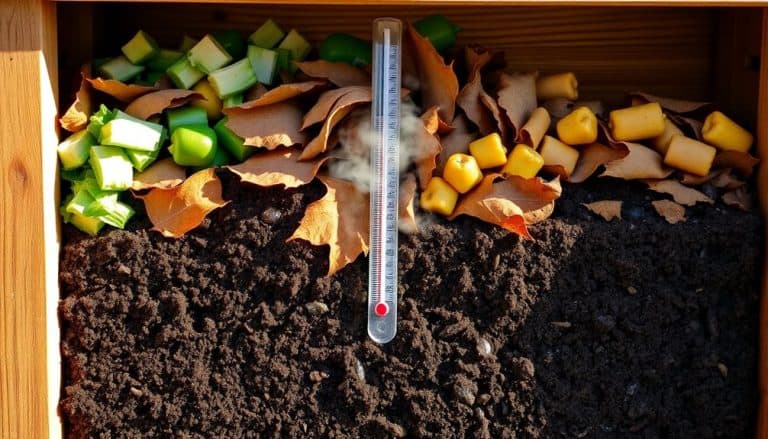This website contains affiliate links. Some products are gifted by the brand to test. As an Amazon Associate, I earn from qualifying purchases. The content on this website was created with the help of AI.
You’ll need five key elements to start worm composting: a well-ventilated bin, proper bedding, red wiggler worms, kitchen scraps, and basic maintenance knowledge. Begin with an opaque container that has drainage holes and a tight lid, then add moistened shredded paper bedding 4-6 inches deep. Purchase about 1 pound of red wigglers per square foot of bin surface area. Feed them fruit and vegetable scraps buried beneath the bedding, avoiding meat, dairy, and citrus. Maintain ideal conditions by keeping the bin at 55-77°F with proper moisture levels. The following steps will guarantee your worm colony thrives and produces nutrient-rich castings.
Key Takeaways
- Choose an opaque container with drainage holes, aiming for 1 square foot per pound of weekly food waste.
- Fill bin with damp, shredded paper or cardboard bedding to a depth of 4-6 inches.
- Add red wiggler worms, using approximately 1 pound of worms per square foot of bin surface area.
- Begin feeding worms small pieces of fruit and vegetable scraps, burying them beneath the bedding.
- Maintain moisture like a wrung-out sponge and keep temperature between 55-77°F for optimal composting.
Choose Your Worm Bin
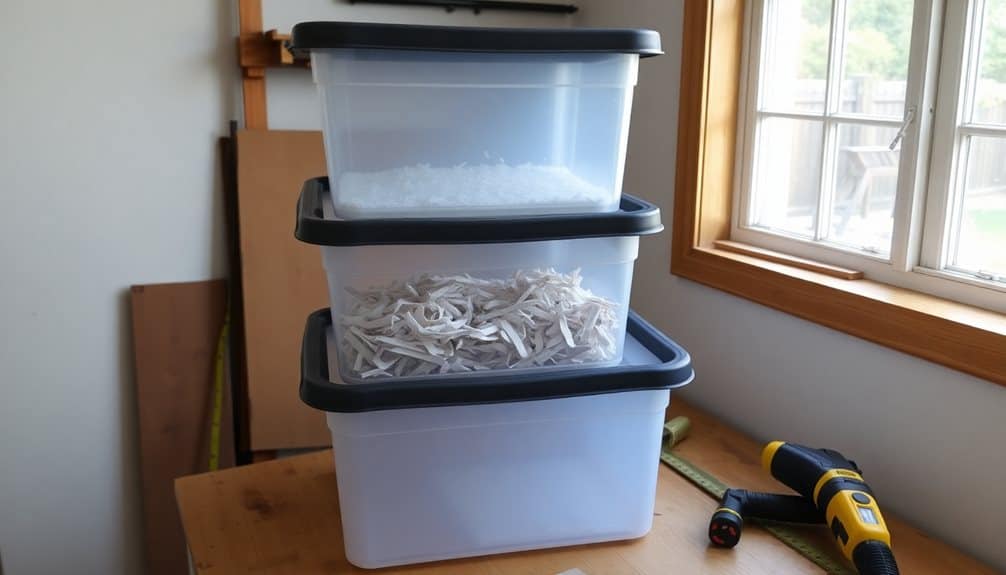
A proper worm composting system begins with selecting an appropriate container that’ll house your worms and organic waste. Choose a bin that’s opaque, well-ventilated, and between 8 to 16 inches deep. You’ll need approximately one square foot of surface area per pound of food waste produced weekly.
Plastic storage containers work effectively and are cost-efficient. Drill 1/8-inch drainage holes in the bottom every 2 inches and ventilation holes along the upper sides. Wood bins offer natural insulation but require weather-resistant varieties like cedar. Metal containers aren’t recommended as they can overheat and leach harmful substances.
Your bin needs a tight-fitting lid to maintain moisture and keep pests out. Place a tray underneath to catch excess liquid, known as leachate. For indoor composting, stack two identical bins – the top bin for composting and the bottom bin to collect drainage. If you’re processing large amounts of waste, consider a continuous flow-through system where finished compost drops through a grated bottom while fresh material’s added on top. These specialized systems are more expensive but offer easier harvest access. Multi-tray systems can maximize space while providing efficient composting solutions for any garden size.
Prepare the Bedding Material

The next essential step in worm composting involves creating proper bedding material that’ll support your worms’ survival and reproduction. You’ll need to shred newspaper, cardboard, or office paper into 1-inch strips, avoiding glossy paper or colored inks that can contain harmful chemicals. These materials provide the carbon-rich environment vital for worm habitat.
To prepare the bedding, soak the shredded paper in water for 10 minutes, then squeeze out excess moisture until it feels like a wrung-out sponge. The bedding should be damp but not dripping – about 70-80% moisture content. Spread this material evenly in your bin to a depth of 4-6 inches.
Add a handful of garden soil or aged compost to introduce beneficial microorganisms and grit that aids worm digestion. You can also include crushed eggshells for additional calcium and grit. Fluff the bedding to create air pockets, which are essential for proper ventilation and preventing anaerobic conditions. Your worms will consume this bedding along with food scraps, so you’ll need to replenish it periodically as it breaks down.
Select the Right Worms
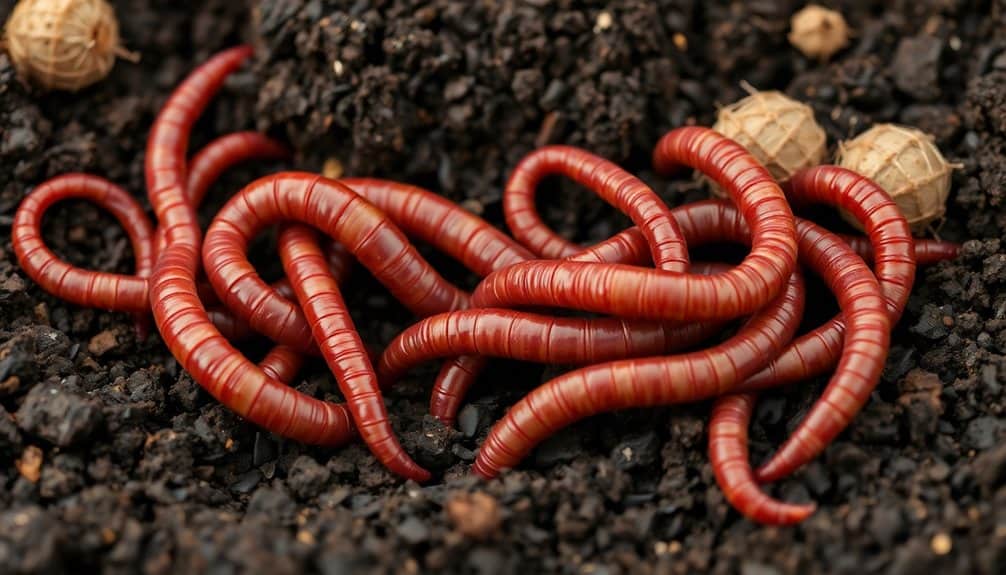
Successful worm composting depends entirely on choosing the right species for your bin. Red wigglers (Eisenia fetida) and red worms (Lumbricus rubellus) are the two most effective species for vermicomposting, with red wigglers being the preferred choice. Don’t use nightcrawlers or common garden earthworms, as they won’t thrive in the confined conditions of a worm bin.
You’ll need approximately 1 pound of worms for every square foot of bin surface area. Red wigglers can process up to half their body weight in organic matter daily, so calculate your needs based on your expected food waste volume. Purchase your worms from reputable suppliers who specialize in vermicomposting – they’re available online or at local garden centers.
When selecting worms, verify they’re active and healthy. Look for worms that quickly respond to light by burrowing away and appear pinkish-red without visible injuries or swelling. If you notice many dead worms or cocoons in your purchase, contact your supplier immediately. Your initial worm population will multiply naturally over time if conditions are favorable, so starting with healthy specimens is essential. These beneficial garden helpers will improve soil structure while producing nutrient-rich castings for your plants.
Add Kitchen Scraps Properly
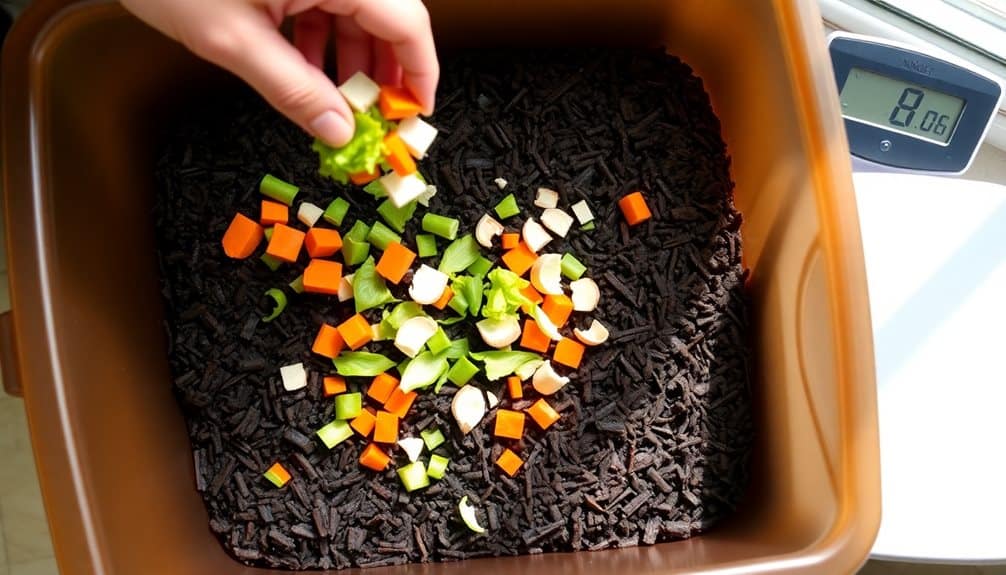
Feeding your worms requires careful attention to both food selection and placement within the bin. Add fruit and vegetable scraps, coffee grounds, tea bags, crushed eggshells, and plain paper products. Don’t include meat, dairy, oils, citrus, onions, or processed foods, as these can harm your worms or create unpleasant odors.
Cut food scraps into small pieces (1-inch or smaller) to help worms process them more efficiently. Bury the scraps 2-3 inches beneath the bedding in a different spot each time you feed. This practice prevents fruit flies and maintains proper moisture levels. Start with a small amount – about 1/2 pound of scraps per pound of worms per week.
Monitor the bin’s contents regularly. If food isn’t being consumed within 3-4 days, you’re overfeeding. Look for signs of decomposition and adjust portions accordingly. Keep a log of what you’ve added and where you’ve placed it. When you notice the worms aren’t eating quickly enough, reduce portions or frequency. Maintain a balanced carbon-to-nitrogen ratio by adding dry bedding materials whenever you include wet food scraps. For optimal worm health and composting efficiency, maintain temperatures between 55°F and 77°F throughout the year.
Maintain Your Worm Colony

Maintaining a thriving worm population requires consistent monitoring of key environmental conditions within your bin. Check the moisture level weekly by squeezing a handful of bedding – it should feel like a wrung-out sponge. If it’s too dry, spray with dechlorinated water; if too wet, add dry bedding materials. Monitor the temperature, keeping it between 55-77°F (13-25°C) for ideal worm activity.
Monitor your worm population’s health by observing their behavior and appearance. Healthy worms should appear pink or reddish-brown, move actively when disturbed, and cluster around food sources. If worms try to escape, check for acidic conditions, excess moisture, or protein-heavy foods. Test the pH every two weeks, maintaining it between 6.0-7.0.
Harvest castings every 3-4 months to prevent toxic buildup of waste products. When harvesting, remove finished compost and replace it with fresh bedding. Count your worms periodically – a healthy colony doubles every 90 days. If the population decreases, reassess feeding amounts, moisture levels, and temperature. Remove any dead worms promptly to prevent bacterial growth that could harm the colony. Consider adding yellow cornmeal as a supplemental food source to enhance worm growth and reproduction.
Frequently Asked Questions
Can Worm Composting Bins Be Kept Indoors Without Creating Unpleasant Odors?
You can keep worm composting bins indoors without odor issues if you maintain them correctly. Confirm proper moisture levels (like a wrung-out sponge), avoid overfeeding, bury food scraps completely, and maintain a balanced carbon-to-nitrogen ratio. If you’re noticing any smells, you’ll need to adjust your bin’s conditions. A well-maintained worm bin should smell earthy, similar to fresh garden soil.
How Long Does It Take for Worms to Produce Usable Compost?
While you might worry it’ll take forever, worm composting is surprisingly efficient. You’ll typically have usable compost in 3-6 months, depending on your setup’s conditions. Temperature (60-77°F), moisture (70-80%), and feeding rate directly impact processing speed. Your worms can process up to half their body weight daily, so a pound of worms handles about 4 pounds of waste weekly under ideal conditions.
What Should I Do With My Worm Bin When Going on Vacation?
When you’re going on vacation, prepare your worm bin for your absence by feeding the worms extra bedding material like shredded paper or cardboard. Make sure the moisture level is ideal—damp but not wet. You’ll want to remove any fresh food scraps that could rot and position the bin in a temperature-controlled area (60-80°F). For trips longer than two weeks, ask a friend to check on your worms.
Can Worms Survive Extreme Temperatures in Outdoor Composting Bins?
Your worms won’t survive in extreme temperatures. They thrive between 55-77°F (13-25°C). Temperatures above 85°F (29°C) can kill them, while freezing conditions are fatal. You’ll need to insulate your outdoor bin during winter using straw, leaves, or blankets. In summer, move it to a shaded area and maintain moisture levels. For best results, consider relocating your bin indoors during extreme weather conditions.
What Are the Signs That Indicate My Worm Population Is Unhealthy?
You’ll notice several warning signs if your worms aren’t thriving. Watch for worms trying to escape the bin, clustering together in balls, or appearing thin and pale. A strong, foul odor indicates poor conditions, while a declining population suggests reproduction problems. Dead worms, especially in large numbers, signal serious issues with moisture, temperature, or food. Check for protein strings (dead worm remains) on the bin’s surface.

